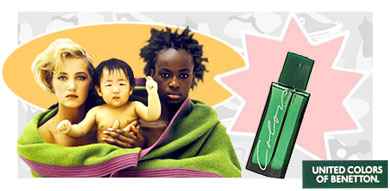Benetton

Fashion Synopsis
“All the world’s colors!”
Controversy abounds when Benetton is around. The brainchild of founder Luciano Benetton, the Italian company has shocked, disturbed, and inspired since 1965. The United Colors of Benetton sold more than clothes, they sold an image of cultural diversity and acceptance with controversial ad campaigns promoting their international flavor.
A fashion-forward apparel company, Benetton found incredible success in the U.S. when the lure of Eurochic wooed the 80’s. The company capitalized on the growing obsession with both European style and social awareness, creating clothes in bold colors and sophisticated shapes.
Benetton means ‘colors,’ and the company utilized this notion in their first major ads in the 1980’s. Oliviero Toscani, the man behind the brilliant photographs for the ads, joined the team in 1982, as Benetton began to sell clothes through exciting campaigns.
The ads featured multi-racial models in festive togetherness wearing bright sweaters (the heart of Benneton) and other bright clothes. Kids and adults of all different colors, ethnicities and gender shared the page in universal understanding and joy...and they all wore Benetton. Clothes were bright and bold, and the Benetton name became synonymous with European (and global) sophistication.
The United Colors of Benetton expanded into the perfume market with Colors in 1988, and in 1991 they began promoting their notorious ads with a magazine, Colors, devoted to their multi-racial, multi-cultural message. The company continued to expand with housewares, mineral water, condoms, car racing and everything in between (and you can imagine how much is in between those four items). On the clothing front, Benetton introduced Playlife, a line marketed for young men that included sports gear. The company partnered with Sears for a more affordable line of Benetton USA, then lost the contract when Benetton planned to release an ad campaign with death-row inmates.
Benetton lost its place in the U.S. market, as the company became better known for its infamous P.R. than its clothes. The label has instead become a global franchise, with clothes now take a backseat to the lifestyle. The understated image of the Gap replaced the aggressive social advertising of Benneton in clothing campaigns as the 90’s came to a close, but the company remains true to its colorful, bold heritage.
Fashion Sub Categories
girl's apparelboy's apparel
brands
